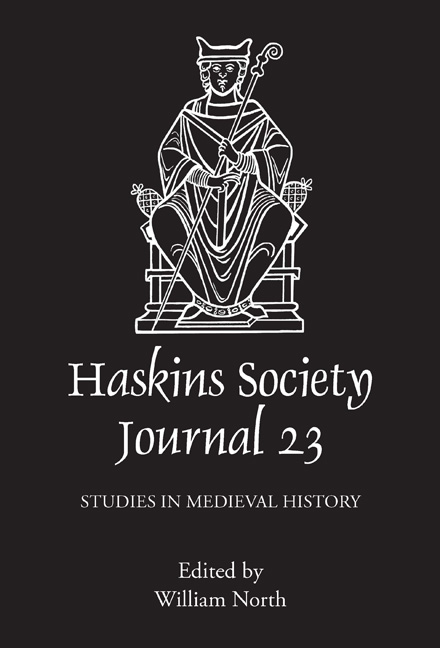Book contents
- Frontmatter
- Contents
- List of Figures
- Editor's Note
- Abbreviations
- 1 Francia and the History of Medieval Europe
- 2 Royal Control and the Disposition of Estates in Tenth-Century England: Reflections on the Charters of King Eadwig (955–959)
- 3 Denis Bethell Prize Essay: Frutolf of Michelsberg's Chronicle, the Schools of Bamberg, and the Transmission of Imperial Polemic
- 4 Manipulating Historical Memory: Cosmas on the Sees of Prague and Olomouc
- 5 Poetry and History: Baudry of Bourgueil, the Architecture of Chivalry, and the First Crusade
- Authors' Preface to Chapters 6 and 7
- 6 Men and Masculinities at the Courts of the Anglo-Norman Kings in the Ecclesiastical History of Orderic Vitalis
- 7 Men and Masculinities in William of Malmesbury's presentation of the Anglo-Norman Court
- 8 The Personnel of Comital Administration in Greater Anjou, 1129–1151
- 9 The Murder of Gilbert the Forester
- 10 The Object as Subject in Medieval Art
6 - Men and Masculinities at the Courts of the Anglo-Norman Kings in the Ecclesiastical History of Orderic Vitalis
Published online by Cambridge University Press: 05 November 2014
- Frontmatter
- Contents
- List of Figures
- Editor's Note
- Abbreviations
- 1 Francia and the History of Medieval Europe
- 2 Royal Control and the Disposition of Estates in Tenth-Century England: Reflections on the Charters of King Eadwig (955–959)
- 3 Denis Bethell Prize Essay: Frutolf of Michelsberg's Chronicle, the Schools of Bamberg, and the Transmission of Imperial Polemic
- 4 Manipulating Historical Memory: Cosmas on the Sees of Prague and Olomouc
- 5 Poetry and History: Baudry of Bourgueil, the Architecture of Chivalry, and the First Crusade
- Authors' Preface to Chapters 6 and 7
- 6 Men and Masculinities at the Courts of the Anglo-Norman Kings in the Ecclesiastical History of Orderic Vitalis
- 7 Men and Masculinities in William of Malmesbury's presentation of the Anglo-Norman Court
- 8 The Personnel of Comital Administration in Greater Anjou, 1129–1151
- 9 The Murder of Gilbert the Forester
- 10 The Object as Subject in Medieval Art
Summary
‘I got in with the ugly crowd, a crowd of serious deadbeats, lowlifes, unrepentant no-good punks…’
Barack Obama, on campaign in 2008The words of the forty-fourth president of the United States, referring to the members of the US Senate, would have been instantly recognized and admired by twelfth-century writers of political narrative, as an instance of facetia, the demonstration of an urbane wit intended to oil the cogs of a tightly wound, fast-moving, court society. Over the last three decades, there has been an increasing accumulation of scholarly discussion on the nature, function, and historical significance of this social world and the place of gender within it. Much of it has been written, explicitly or implicitly, in response to Norbert Elias' classic, The Civilizing Process, which was published in 1939 but much more widely consulted after its English translation decades later. There Elias argued that it was the courts of early modern European monarchs that first came to act as powerful mechanisms for regularized competition and political cohesion by taming the fiercely independent and volatile instincts and activities of warrior elites.
A grand claim with a specific chronology, like the rise of the ‘middling sort’, or the discovery of the individual, or the emergence of emotional commitment within the family, Elias' thesis threw down a gauntlet of modernization theory irresistible to medievalists. C. Stephen Jaeger was one of the first to claim courtliness for the medieval period, by tracing its origins back to tenth-century Germany and the Ottonian ‘courtier bishop’.
- Type
- Chapter
- Information
- The Haskins Society Journal 232011. Studies in Medieval History, pp. 105 - 114Publisher: Boydell & BrewerPrint publication year: 2014

